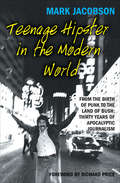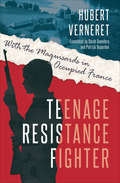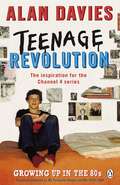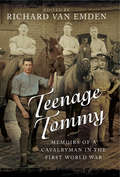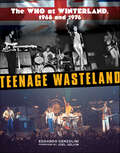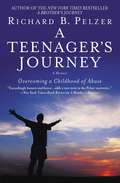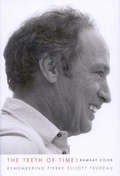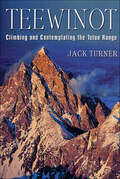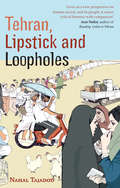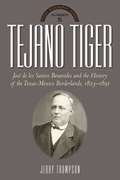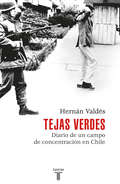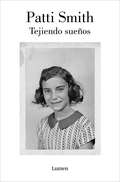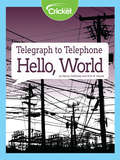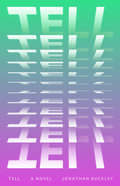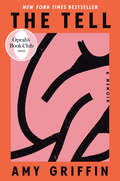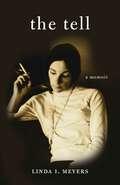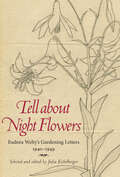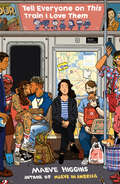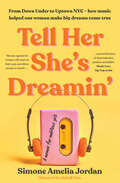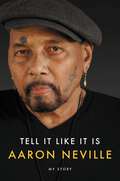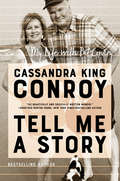- Table View
- List View
Teenage Hipster in the Modern World: From the Birth of Punk to the Land of Bush: Thirty Years of Apocalyptic Journalism
by Mark Jacobson“Nothing less than a riveting snapshot of life in the ‘modern world,’ particularly New York.” —Booklist Mark Jacobson has published pieces in Rolling Stone, the Village Voice, Esquire, and more. His journalistic beats range far and wide, delving into the realms of politics, sports, and celebrities in pieces on such luminaries as Bob Dylan, Julius Erving, Chuck Berry, Pam Grier (in her Scream Blacula Scream days), Martin Scorsese, and many others. But for Jacobson, New York City has always been topic number one. Jacobson tells the story of the city in these classic essays covering three decades—from the beginnings of punk rock back in the times of “pre-gentrification” to the heart-wrenching days of 9/11. “A brilliant collection by one of our most valuable journalists.” —Pete Hamill Includes a foreword by Richard Price
Teenage Resistance Fighter: With the Maquisards in Occupied France
by Hubert Verneret&“A history book that reads like a novel, this testimony comes from one of the last living eyewitnesses&” of the Nazi occupation of France (Christiane Amanpour, CNN Chief International Correspondent). September 5, 1944 The Americans are approaching; we follow their progress impatiently on the radio, by intercepting messages reserved for the commandos. They cannot be beaten now. But it is up to us to do the impossible to speed up the progression of the bulk of their troops, to facilitate the advance of their spearhead, and, above all, to prevent the Germans from withdrawing to the Rhine in good order, with all their equipment. How many human lives will we manage to save? Hubert Verneret was a fourteen-year-old schoolboy in Burgundy when the Nazis invaded Poland and fifteen when France fell. A Boy Scout, he helped refugees and the gendarmerie, moved wounded soldiers, and dug out bodies after air raids. Throughout, he kept a diary recording his actions, thoughts, and feelings as French troops retreated and Germans arrived. In 1944, at nineteen, he decided to join the local maquis resistance fighters, operating from a hidden base in the forest. Though constantly in danger, he found himself frustrated, as he felt fated never to fight the Germans directly, never to take a prisoner. As the Allies approached, the maquisards worked to upset and weaken the retreating Germans to aid the Allied advance. Hubert details the joy with which the maquisards were welcomed in local villages when the fighting ended. Only as he listened to the speech given as the maquisards disbanded did he understand that his part in the war, while perhaps not heroic as that played by others, was still important in gaining the victory. Years later, Hubert interviewed local maquisards to understand more about maquis history; their words and excerpts from the diary of a local civilian during the German retreat provide context to Hubert&’s youthful testimony. This first English edition of Hubert&’s diary retains the original prefaces by Col. Buckmaster, chief of the French section of the SOE, and Col. d&’Escrienne, aide de camp to Gen. de Gaulle.
Teenage Revolution
by Alan DaviesWhen Alan Davies was growing up he seemed to drive his family mad. 'What are we going to do with you?' they would ask - as if he might know the answer.Perhaps it was because he came of age in the 1980s. That decade of big hair, greed, camp music, mass unemployment, social unrest and truly shameful trousers was confusing for teenagers. There was a lot to believe in - so much to stand for, or stand against - and Alan decided to join anything with the word 'anti' in it. He was looking for heroes to guide him (relatively) unscathed into adulthood.From his chronic kleptomania to the moving search for his mother's grave years after she died; from his obsession with joining (going so far as to become a member of Chickens Lib) to his first forays into making people laugh (not always intentionally); Teenage Revolution is a touching and funny return to the formative years that make us all.
Teenage Tommy: Memoirs Of A Cavalryman In The First World War
by Richard van EmdenBenjamin Clouting was just sixteen years old when he embarked with the British Expeditionary Force for France in August 1914. The youngest man in the 4th Dragoon Guards, he took part in the BEF's celebrated first action at Casteau on August 22nd, and, two days later, had his horse shot from under him during the famous cavalry charge of the 4th Dragoon Guards and the 9th Lancers at Audregnies. Ben served on the Western front during every major engagement of the war except Loos, was wounded twice, and in 1919 went with the Army of Occupation to Cologne. The son of a stable groom, Ben was brought up in the beautiful Sussex countryside near Lewes and from his earliest years was, as he often said himself, "crazy to be a soldier". He worked briefly as a stable boy before joining up in 1913; his training was barely completed when war broke out. The Regiment, knowing Ben to be under age, tried to stop him embarking for France, but he flatly refused to be left behind. During the next four years, he served under officers immortalized in Great War history, including Major Tom Bridges, Captain Hornby, and Lieutenant-Colonel Adrien Carton de Wiart VC.Teenage Tommy is a detailed account of a trooper's life at the front, vividly recalling, for example, the privations suffered during the retreat from Mons. and later, the desperate fighting to hold back the German onslaught at 2nd Ypres. But this is more than just a memoir about trench warfare. Ben's lively sense of humor and healthy disrespect for petty restrictions make this an entertaining as well as a moving story of life at the front.
Teenage Wasteland: The Who at Winterland, 1968 and 1976
by Edoardo GenzoliniThe reason I am writing this book is because it has never been properly given credit to the real cradle of the Who&’s success: San Francisco. The concerts the Who played at promoter Bill Graham&’s Bay Area venues made them grow exponentially and unified them as a band at a time that guitarist Pete Townshend recalled as artistically and financially draining. San Francisco held the band together, gave it confidence and the right input that made it become what it is known for today. The two Winterland concerts in 1968 and 1976 are pivotal, in that 1968 is the one in which the most interesting experimentation took place, while the 1976 performance is considered the band&’s Zenit by everyone that was there.
A Teenagers Journey: Overcoming a Childhood of Abuse
by Richard B. PelzerMany thousands of readers were moved by Richard B. Pelzer's heart-wrenching memoir, A Brother's Journey, in which he detailed the horrifyingly abusive childhood he endured at the hands of his mother, whose treatment of her children was first revealed by Dave Pelzer in his own hugely successful memoir, A Boy Called "It". Now, Richard reveals how the abuse inflicted on him as a child continued to affect his life as a teenager. He turned to drugs and contemplated suicide, while simultaneously trying to establish an autonomous life away from his destructive family situation. Yet as he stumbled toward adulthood, fighting and facing his demons, Richard's ultimate struggle toward victory was his alone. His salvation finally came when a surrogate family took him in, offering comfort, hope, and unconditional love --and ultimately the transformational power of forgiveness.
Teeth of Time
by Ramsay CookTrudeau, the most intellectual of Canadian prime ministers, turned to Cook, an illustrious historian and a speech-writer during the 1968 election campaign, for his trusted views. Cook's revealing memoir also traces how public affairs and the central political themes of Trudeau's reign - nationalism, federalism, and constitutional reform - continued to drive their relationship after Trudeau's resignation in 1984.
Teeth of Time: Remembering Pierre Elliott Trudeau (Footprints Series #5)
by Ramsay CookTrudeau, the most intellectual of Canadian prime ministers, turned to Cook, an illustrious historian and a speech-writer during the 1968 election campaign, for his trusted views. Cook's revealing memoir also traces how public affairs and the central political themes of Trudeau's reign – nationalism, federalism, and constitutional reform – continued to drive their relationship after Trudeau's resignation in 1984.
Teewinot: Climbing and Contemplating the Teton Range
by Jack TurnerJack Turner grew up with an image of the Tetons engraved in his mind. As a young man, he climbed the peaks of this singular range with basic climbing gear friends. Later in life, he led treks in India, Pakistan, Nepal, China, Tibet, and Peru, but he always returned to the mountains of his youth. He continues to climb the Tetons as a guide for Exum Mountain, Guides, the oldest and most prestigious guide service in America. Teewinot is his ode to forty years in the mountains that he loves. Like Thoreau and Muir, Turner has contemplated the essential nature of a landscape. Teewinot is a book about a mountain range, its austere temper, its seasons, its flora and fauna, a few of its climbs, its weather, and the glory of the wildness. It is also about a small group of guides and rangers, nomads who inhabit the range each summer and know the mountains as intimately as they will ever be known. It is also a remarkable account of what it is like to live and work in a national park. Teewinot has something for everyone: spellbinding accounts of classic climbs, awe at the beauty of nature, and passion for some of the environmental issues facing America today. In this series of recollections, one of America's most beautiful national parks comes alive with beauty, mystery, and power. The beauty, mystery, and power of the Grand Tetons come alive in Jack Turner's memoir of a year on America's most beautiful mountain range.
Tehran, Lipstick and Loopholes
by Nahal TajadodA wry and humorous account of the author's quest to get her Iranian passport renewed. She embarks on a bizarre and circuitous journey, meeting a colourful cast of characters along the way: two photographers who specialise in Islamic portraits, a forensic surgeon who trades in human organs, a madam who wants to send prostitutes to Dubai and a grandmother who offers a live chicken to an implacable official.Tehran, Lipstick and Loopholes is a fascinating look at the constraints and contradictions of contemporary life in Tehran from the author's unique standpoint of being both a native of Iran and a foreigner.
Tehran, Lipstick And Loopholes
by Nahal TajadodA wry and humorous account of the author's quest to get her Iranian passport renewed. She embarks on a bizarre and circuitous journey, meeting a colourful cast of characters along the way: two photographers who specialise in Islamic portraits, a forensic surgeon who trades in human organs, a madam who wants to send prostitutes to Dubai and a grandmother who offers a live chicken to an implacable official.Tehran, Lipstick and Loopholes is a fascinating look at the constraints and contradictions of contemporary life in Tehran from the author's unique standpoint of being both a native of Iran and a foreigner.
Tejano Tiger: Jose de los Santos Benavides and the Texas-Mexico Borderlands, 1823-1891 (The Texas Biography Series #5)
by Jerry ThompsonIt was under the Confederacy in the disputed Texas-Mexico borderlands that Santos Benavides reached the pinnacle of his military career as the highest-ranking Tejano in the entire Confederate army. In the decades that followed the Civil War, he became an esteemed political leader, highly respected on both sides of the border. This is the first scholarly study of this important historical figure.
Tejas verdes: Diario de un campo de concentración en Chile
by Hernán ValdésUno de los más importantes registros escritos sobre la brutalidad de la dictadura militar en Chile Tejas Verdes, uno de los campos de detención y exterminio creados por la dictadura de Pinochet, fue el lugar donde ocurrieron, entre febrero y marzo de 1974, los hechos descritos en este libro. Publicado en Barcelona un año después del golpe de estado, el testimonio de Hernán Valdés -torturado en ese recinto- fue el primero en describir en detalle la máquina de terror desatada por los militares contra los chilenos afines a la Unidad Popular. Este libro, de admirable fuerza narrativa y al mismo tiempo de implacable autocrítica en el plano político, sigue siendo una pieza clave para descubrir y describir la brutalidad que marcó a Chile. Tejas Verdes representa un inestimable documento que no tuvo otra pretensión que, en palabras del propio autor, "mostrar a la opinión pública la cara oculta, la intimidad -por así decir- de la brutalidad militar chilena, que meses después del golpe de estado, pese a la abundante información periodística, era casi completamente ignorada en lo concerniente a la rutina de la tortura en los campos de concentración".
Tejiendo sueños
by Patti SmithUn pequeño libro de memorias que puede leerse como el complemento perfecto de Éramos unos niños. A veces bastan unos calcetines viejos llenos de canicas, un cobertizo negro habitado por murciélagos y una mochila cargada de trastos imposibles para coser un libro pequeño y hermoso, unas memorias hechas de detalles cotidianos que el talento de Patti Smith ha convertido en una chistera llena de palabras mágicas. «Alguien me preguntó si Tejiendo sueños podía considerarse un cuento de hadas. Siempre me ha encantado ese tipo de historias, pero no creo que lo sea. Todo lo que contiene este librito es cierto, y tal como está escrito ocurrió. Escribirlo me arrancó de mi extraño letargo y espero que en alguna medida llene al lector de una vaga y curiosa alegría.»Patti Smith La crítica ha dicho...«Patti Smith no solo es una gran artista, es una hechicera, es decir, alguien en contacto con otros niveles de la realidad.»William S. Burroughs «Patti Smith nos ha honrado con una obra maestra, una espléndida invitación a abrir un cofre de los tesoros que nunca antes se había abierto.»Johnny Depp «Patti Smith fue hace tiempo el heraldo salvaje de Rimbaud, pero el dolor la convirtió en un San Juan de la Cruz, una persona mística llena de misericordia.»Edmund White
Telegraph to Telephone: Hello, World
by Nancy GallowayDid you know that writing letters used to be the only way to communicate with people far away? Samuel F.B. Morse changed all of that when he invented the telegraph and Morse code! Using wires and electromagnetism, Morse found a way to communicate over long distances almost instantly. This new technology paved the way for the telephone, as well as the other methods of communication we use today!
TelePizza: (Abridged)
by Lynda M. Applegate"As he walked towards the exit of a recently opened TeleGrill in Madrid, Leopoldo Fernández, founder and CEO of TelePizza, paused. It was Thursday, October 22, 1998, and the restaurant was quiet. Only three diners were seated at tables, and the delivery people were waiting for orders. Fernández knew that it was too early in the evening to expect much activity, but the TeleGrill concept was still relatively new and untested. Fernández and his executive team had spent many hours planning the TeleGrill concept, but he knew that planning wasn’t everything in the restaurant business. What really mattered was the number and timing of improvement iterations early in the life of a concept. He wanted TeleGrill to be a unique new restaurant concept for Spain, as TelePizza had been when launched in 1988."
Tell
by Jonathan BuckleyCo-winner of the 2022 Novel Prize, Tell is an exuberant, intensely fluid, and probing examination of the ways in which we make stories of our own and of other people’s lives A novel of intense, flickering intelligence, Tell is structured as a series of interviews with a woman who worked as a gardener for a wealthy businessman and art collector who has mysteriously disappeared, and may or may not have committed suicide. What might be a gloomy subject is instead alluring, lit from within by a lively deep knowledge of human nature: Buckley's eye for motivations brings to mind a Thomas Hardy for our atomized 21st-century. A thrilling novel of strange, intoxicating immediacy, Tell carries the pleasures of exciting new gossip enjoyed with a rare old cognac by a crackling fire. Calling his work “captivating,” John Banville has asked: “Why isn’t Jonathan Buckley better known?”
The Tell: A Memoir
by Amy Griffin<b>NEW YORK TIMES BESTSELLER</b> OPRAH&’S BOOK CLUB PICK <p> An astonishing memoir that explores how far we will go to protect ourselves, and the healing made possible when we face our secrets and begin to share our stories. <p> “A beautiful account of the journey of courage it takes to face the truth of one’s past.”—Bessel van der Kolk, #1 New York Times bestselling author of The Body Keeps the Score. <p> For decades, Amy ran. Through the dirt roads of Amarillo, Texas, where she grew up; to the campus of the University of Virginia, as a student athlete; on the streets of New York, where she built her adult life; through marriage, motherhood, and a thriving career. To outsiders, it all looked, in many ways, perfect. But Amy was running from something—a secret she was keeping not only from her family and friends, but unconsciously from herself. <p> “You’re here, but you’re not here,” her daughter said to her one night. “Where are you, Mom?” So began Amy’s quest to solve a mystery trapped in the deep recesses of her own memory—a journey that would take her into the burgeoning field of psychedelic therapy, to the limits of the judicial system, and ultimately, home to the Texas panhandle, where her story began. In her search for the truth, to understand and begin to recover from buried childhood trauma, Griffin interrogates the pursuit of perfectionism, control, and maintaining appearances that drives so many women, asking, when, in our path from girlhood to womanhood, did we learn to look outside ourselves for validation? What kind of freedom is possible if we accept the whole story and embrace who we really are? With hope, heart, and relentless honesty, she points a way forward for all of us, revealing the power of radical truth-telling to deepen our connections—with others and ourselves. <b>New York Times Bestseller</b>
The Tell: A Memoir
by Linda I. MeyersLinda I. Meyers was twenty-eight and the mother of three little boys when her mother, after a lifetime of threats, killed herself. Staggered by conflicting feelings of relief and remorse, Linda believed that the best way to give meaning to her mother&’s death was to make changes to her own life. Bolstered by the women&’s movement of the seventies, she left her marriage, went to college, started a successful family acting business, and established a fulfilling career. Written with irony and humor and sprinkled with Yiddish, The Tell is one woman&’s inspirational story of before and after, and ultimately of emancipation and purpose.
Tell about Night Flowers: Eudora Welty's Gardening Letters, 1940-1949
by Julia EichelbergerTell about Night Flowers presents previously unpublished letters by Eudora Welty, selected and annotated by scholar Julia Eichelberger. Welty published many of her best-known works in the 1940s: A Curtain of Green, The Wide Net, The Robber Bridegroom, Delta Wedding, and The Golden Apples. During this period, she also wrote hundreds of letters to two friends who shared her love of gardening. One friend, Diarmuid Russell, was her literary agent in New York; the other, John Robinson, was a high school classmate and an aspiring writer who served in the Army in WWII, and long the focus of Welty's affection. Welty's lyrical, witty, and poignant discussions of gardening and nature are delightful in themselves; they are also figurative expressions of Welty's views of her writing and her friendships. Taken together with thirty-five illustrations, they form a poetic narrative of their own, chronicling artistic and psychic developments that were underway before Welty was fully conscious of them. By 1949 her art, like her friendships, had evolved in ways that she would never have predicted in 1940. Tell about Night Flowers not only lets readers glimpse Welty in her garden; it also reveals a brilliant and generous mind responding to the public events, people, art, and natural landscapes Welty encountered at home and on her travels during the 1940s. This book enhances our understanding of the life, landscape, and art of a major American writer.
Tell Everyone on This Train I Love Them
by Maeve HigginsDeeply funny, moving, and urgent writing about a country that can feel broken into pieces and the light that shines through the cracks, from Irish comedian Maeve Higgins, author of Maeve in America. As an eternally curious outsider, Maeve Higgins can see that the United States is still an experiment. Some parts work well and others really don&’t, but that doesn't stop her from loving the place and the people that make it. With piercing political commentary in a sweet and salty tone, these essays unearth answers to the questions we all have about this country we call home; the beauty of it all and the dark parts too. Maeve attends the 2020 Border Security Expo to better understand the future of our borders, and finds herself at The Alamo surrounded by queso and homemade rifles. A chance encounter with a statue of a teenage horseback rider causes her to interrogate the purpose of monuments, this sends her hurtling through the past, connecting Ireland&’s revolutionary history with the struggles of Black Americans today. And after mistaking edibles for innocent candies, Maeve gets way too high at Paper Source. Most of all, Maeve wants to leave this country and this planet better than she found it. That may well be impossible, but it certainly means showing love. Lots of it, even when it's difficult to do so. Threaded through these pieces is love for strangers, love for friends who show up right on time, love for trees, love for Tom Hardy, love for those with differing opinions, love for the glamorous older women of Brighton Beach with tattooed eyeliner and gold jewelry, love for everybody on this train.
Tell Her She's Dreamin': A memoir for ambitious girls
by Simone Amelia JordanThis book is a love letter to women longing to break free of the boxes their postcode, skin colour, gender and bank balance put them in. Its title is a rebel yell to ambitious women and girls hungry for more. Growing up on the whitewashed Central Coast in the 1980s and attending an elite school as a scholarship student from the wrong side of the tracks, Lebanese-Cypriot Simone Amelia Jordan felt like an outcast among her peers for years. Her lifeline was hip-hop, then in its golden age. From girlhood, Simone recognised the art form's pro-Black consciousness, and the rappers' resonant words inspired her to embrace her own identity and back herself. From founding Australia's most successful hip-hop and R&B publication to moving to New York City and interviewing the biggest stars of the time as the editor of the world's most beloved rap magazine; falling in love and getting her heart broken; grappling with her family ties to culture; and struggling through illness and sexual grooming, Simone's inspiring story is about defying the odds to reach for your dreams. But it is also about figuring out those dreams can change as you do.Tell Her She's Dreamin' is a deeply personal story of family, culture and music that disrupts the long-held view that women, and racially diverse women especially, are limited in their power as bold, playful explorers. It is a timely manual for those hellbent on going places and an inspiration for anyone who has ever been told they can't. (Spoiler alert: you can!)
Tell It Like It Is: My Story
by Aaron NevilleNAMED A BEST BOOK OF 2023 BY BEST CLASSIC BANDS For the first time, legendary singer and songwriter and Grammy Hall-of-Famer Aaron Neville tells his personal story of overcoming poverty, racism, addiction, and loss through faith, family, and music. Aaron Neville&’s first #1 hit, &“Tell It Like it Is,&” was released in 1966. In the mid-70s he formed the Neville Brothers with Art, Charles, and Cyril—now known as the &“First Family of New Orleans&”—and they released more than a dozen influential albums. Given his one-of-a-kind, soaring falsetto, Aaron was the breakout star, and over the next six decades, he had four platinum albums, three #1 songs, numerous film and television appearances, and was inducted into the Grammy Hall of Fame in 2014. His triple-platinum duets with Linda Ronstadt (including the Grammy-Award-winning hit &“I Don&’t Know Much&”) showcased the softer side of his voice, and the smoking hot funky soul of the Neville Brothers cemented his legacy as an R&B legend. But few people know the challenging and circuitous road Aaron took to fame. Born in a housing project in New Orleans of Black and Native American heritage, Aaron struggled as a teenage father working to raise a family while building his career as a musician, surviving a stint in jail for car theft and many years battling heroin addiction. Recognized by the dagger tattoo on his cheek and his St. Jude medallion earring, Neville credits St. Jude—the patron saint of lost cases—for turning his life around. He found healing and salvation in music. Aaron Neville is a man who by all accounts should not have made it. Tell It Like It Is shares his story for the first time.
Tell It to the Mafia
by Wyn Hope Joe Donato"Your Honor, we, the people of the State of California intend to ask the death penalty in the trial of Joseph Daniel Donato, accused of murder in the first degree." This is the story of how Joe Donato became a born-again Christian.
Tell Me a Story: My Life with Pat Conroy
by Cassandra King ConroyBestselling author Cassandra King Conroy considers her life and the man she shared it with, paying tribute to her husband, Pat Conroy, the legendary figure of modern Southern literature.Cassandra King was leading a quiet life as a professor, divorced “Sunday wife” of a preacher, and debut novelist when she met Pat Conroy. Their friendship bloomed into a tentative, long-distance relationship. Pat and Cassandra ultimately married, ending Pat's long commutes from coastal South Carolina to her native Alabama. It was a union that would last eighteen years, until the beloved literary icon’s death from pancreatic cancer in 2016.In this poignant, intimate memoir, the woman he called King Ray looks back at her love affair with a natural-born storyteller whose lust for life was fueled by a passion for literature, food, and the Carolina Lowcountry that was his home. As she reflects on their relationship and the eighteen years they spent together, cut short by Pat’s passing at seventy, Cassandra reveals how the marshlands of the South Carolina Lowcountry ultimately cast their spell on her, too, and how she came to understand the convivial, generous, funny, and wounded flesh-and-blood man beneath the legend—her husband, the original Prince of Tides.
